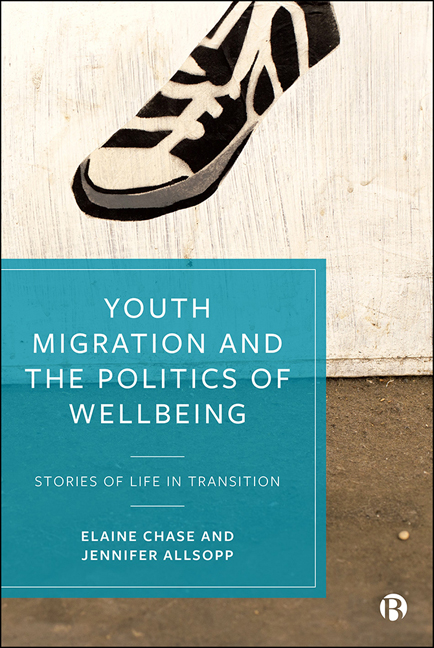Book contents
- Frontmatter
- Contents
- List of Figures
- Acknowledgements
- Foreword
- ‘Future’
- 1 Introduction
- 2 Conceptualizing Wellbeing in the Context of Migration and Youth Transitions
- 3 Capturing Wellbeing in Transition: An Alternative Approach
- 4 ‘Iron Rod’ or ‘Colander’? Welfare Regimes in England and Italy
- 5 The Pursuit of Safety and Freedom
- 6 Legal Integrity and Recognition
- 7 Identity and Belonging
- 8 Constructing Viable Futures as ‘Adults’
- 9 Emotional and Mental Wellbeing
- 10 Friendships, Connections and Relationships
- 11 Transnational Family and Connections
- 12 Conclusion
- Endnotes
- References
- Index
11 - Transnational Family and Connections
Published online by Cambridge University Press: 21 April 2021
- Frontmatter
- Contents
- List of Figures
- Acknowledgements
- Foreword
- ‘Future’
- 1 Introduction
- 2 Conceptualizing Wellbeing in the Context of Migration and Youth Transitions
- 3 Capturing Wellbeing in Transition: An Alternative Approach
- 4 ‘Iron Rod’ or ‘Colander’? Welfare Regimes in England and Italy
- 5 The Pursuit of Safety and Freedom
- 6 Legal Integrity and Recognition
- 7 Identity and Belonging
- 8 Constructing Viable Futures as ‘Adults’
- 9 Emotional and Mental Wellbeing
- 10 Friendships, Connections and Relationships
- 11 Transnational Family and Connections
- 12 Conclusion
- Endnotes
- References
- Index
Summary
‘She sits next to me and strokes me hair and says, “Son, I can't believe it's you, that you’re here, that it's really you, that you’re real.”’
This message arrived from Abugul via Facebook one afternoon. His location revealed that he was now in Belgium, and the picture that accompanied a string of excited messages informed us that after ten long years he had finally been reunited with his mother and brothers from Afghanistan. We read the messages and took in the emotional weight of the moment. He had captured it with a camera phone and sent it to us over 4G. We Facetimed. Everyone was crying with happiness.
Abugul had found his family through a non-governmental organization family tracing programme after losing touch with them when he left Afghanistan on his own 11 years previously. It had been a decade since he arrived in England as an unaccompanied minor at the age of 14. In the six years since he had turned 18, he had lived an undocumented life. As he moved in and out of immigration detention, he had ‘learnt to be illegal’ (Gonzales 2011: 602). When the research began in 2015, Abugul was working in a phone shop in a part of London he described to us as ‘mini-Africa’. He stayed in a small room with other young Afghan men. He worked seven days a week for a poor wage and rarely got out into the city. He was supported by a group of Afghan and English friends who accompanied him to legal appointments and a doctor's clinic for undocumented migrants (he was entitled to primary health care, but was too afraid to use the National Health Service). Because he had absconded and been off the radar for years, Abugul's prospects for regularization were not favourable in the United Kingdom (UK). In what we have elsewhere referred to as a tricky temporal game of ‘tactics of time and status’ (Allsopp et al 2015), his was a strategy of wait and see. During this time, he frequently wrote on social media of his loneliness and thoughts of ending his life.
- Type
- Chapter
- Information
- Youth Migration and the Politics of WellbeingStories of Life in Transition, pp. 191 - 208Publisher: Bristol University PressPrint publication year: 2020

